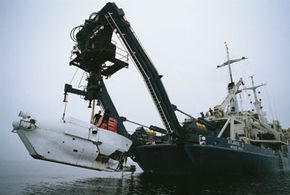Other Uses for Nuclear Submarines
We've learned about the military applications of a nuclear submarine. What are some of its other uses?
The incredible range of a nuclear submarine makes it ideal for exploration. A nuclear submarine first reached the North Pole in 1958. It was a feat made possible by simply navigating the submarine beneath the ice caps found at either pole, and then surfacing by breaking through the ice. Prior to this, exploration of the polar area was extremely difficult. Personnel and materials had to be carried overland through a harsh and bitterly cold environment. Research stations had to be built, maintained and resupplied.
Advertisement
Even today, harsh weather conditions limit overland access to the area at certain times of the year (in addition to subfreezing temperatures, "winter" consists of about six months of uninterrupted darkness). Now, a research team can travel in relative comfort and emerge directly in the middle of an ice cap. The nuclear submarine itself is a self-contained survival unit, and so can directly support a scientific team on a short-term mission.
The unlimited range of a nuclear submarine enabled researchers to take samples of and study different parts of the open seas at the Earth's poles, instead of being confined to conducting studies close to shore. Using sonar and other means, oceanographers have been able to survey and map the ocean floor at both the North and South Pole.
Though the Navy's own research is almost exclusively tied to military functions, it has paved the way for future researchers to access these remote areas to study the aquatic life, search for medicinal elements and analyze the air and shape of the icecaps for signs of environmental damage.
In 1969, the Navy developed the NR-1, a 140-foot-long research submersible that was powered by a refrigerator-sized nuclear reactor. Designed to reclaim sunken enemy subs from great depths, the NR-1 enabled small teams of about seven researchers to conduct studies and take samples as far down as half a mile below the surface. Other than to replenish supplies, the NR-1 can remain in a state of controlled submergence at such depths indefinitely.
In one survey of Scandinavian waters, the NR-1 located the wrecks of 26 ships in half a day. It also was used to locate wreckage from jet fighters and even pinpointed the remains of Challenger space shuttle.
Modern nuclear vessels are capable of reaching great depths, enabling scientists to study the deep-sea creatures and thermal vents found along the ocean's floor.
Continue reading for lots more information about nuclear submarines.
Related HowStuffWorks Articles
More Great Links
Sources
- Colon, Raul. "Flying on Nuclear, The American Effort to Built a Nuclear Powered Bomber ." Aug. 6, 2007 (June 22, 2008). http://www.aviation-history.com/articles/nuke-american.htm
- Commander Submarine Force. U.S. Navy. "Fact Sheets." September, 2007 (June 22, 2008). http://www.sublant.navy.mil/HTML/facts.html
- Denger, Mark J. Speech excerpts. "David Bushnell: Father of the Combat Submarine." 2000. http://submarinehistory.homestead.com/Bushnell.html
- Gibson, Larry, SKC (SS), USN, (RET). U.S. Navy. Email correspondence. June 21, 2008.
- Global Security. "Polaris A-1." April 28, 2005. (June 22, 2008). http://www.globalsecurity.org/wmd/systems/a-1.htm
- "History of USS NAUTILUS (SSN 571)." 2004 (June 22, 2008). U.S. Navy Submarine Force Museum. http://www.ussnautilus.org/history.html
- Kirby, Geoff. "Navies in Transition: A History of the Torpedo; The Early Days." Originally published in the Journal of the Royal Navy Scientific Service, Vol 27 No 1. http://www.btinternet.com/~philipr/torps.htm
- Lake, Jeffrey B. "Russian Submarine was 'Made in America':
- An American Submarine Centennial Story." 2000 (June 22, 2008).http://www.simonlake.com/html/u_s__russian_sub.html
- Molloy, Arthur E. "Arctic Science and the Nuclear Submarine."http://pubs.aina.ucalgary.ca/arctic/Arctic15-2-86.pdf
- Moran, Tracy. "Could women sink U.S. submarines?" USAToday. May 23, 2000. http://www.usatoday.com/news/opinion/columnists/tmoran/tm5.htm
- National Geographic, "K-19." (June 22, 2008). http://www.nationalgeographic.com/k19/
- "Nautilus." Naval Historical Center. May 2007. http://www.history.navy.mil/danfs/n2/nautilus-iv.htm
- "Nuclear Propulsion." Federation of American Scientists. 2000. http://www.fas.org/man/dod-101/sys/ship/eng/reactor.html
- Office of Naval Research. http://www.onr.navy.mil/
- PBS. "See Inside a Submarine." Nova Online. May, 2002 (June 22, 2008). http://www.pbs.org/wgbh/nova/subsecrets/inside.html
- Reeves, Philip. "Chinese Sub Base Prompts Concerns in India." NPR. May 27, 2008.http://www.npr.org/templates/story/story.php?storyId=90864853
- Schwartz, Stephen I. "Converted B-36 Bomber." U.S. Nuclear Weapons Cost Study Project. Atomic Audit: The Costs and Consequences of U.S. Nuclear Weapons Since 1940; Nuclear Weapons, Weapons, Weapons of Mass Destruction, Arms Control, Proliferation.
- Brookings Institution Press. August 1998. http://www.brookings.edu/projects/archive/nucweapons/anp.aspx
- Smithsonian Institution, National Museum of American History. "Fast Attacks and Boomers: Submarines in the Cold War." 2000 (June, 22, 2008). http://americanhistory.si.edu/Subs/const/anatomy/index.html
- "Torpedo." Encyclopædia Britannica. 2008. Encyclopædia Britannica Online. June 22, 2008. http://www.britannica.com/EBchecked/topic/600024/torpedo
- U.S. Navy, Fact File. "Trident Fleet Ballistic Missile." April 3, 2005 (June 22, 2008). http://www.navy.mil/navydata/fact_display.asp?cid=2200&tid=1400&ct=2
